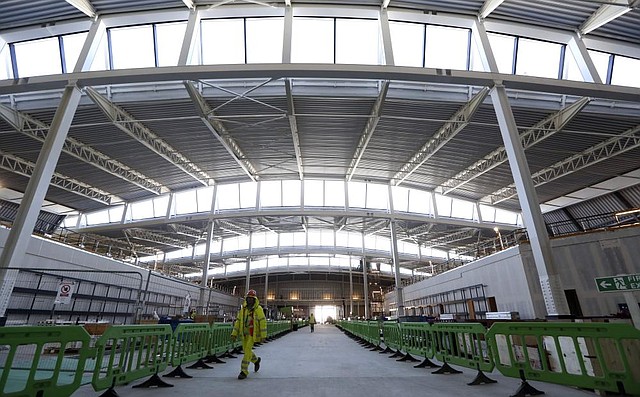Heathrow hub set for slow rollout
London airport aims to avoid ’08 chaos in new terminal
A worker passes through the security checkpoint inside the new Terminal 2 building at Heathrow airport in London during construction work in November. The terminal is set to open June 4 at about 10 percent capacity.
Thursday, March 13, 2014
London Heathrow Airport’s new $4.2 billion Terminal 2 will limit passenger numbers to 2,500, or 10 percent of capacity, when operations start on June 4 to avoid the havoc of the hub’s last major opening.
Daily departures from the new building will still be capped at 6,000 people at the end of June as clients including United Continental Holdings Inc. and Air Canada move in. All 26 carriers set to base flights there are not scheduled to be fully ensconced until November, operations director Brian Woodhead said Wednesday.
Heathrow experienced an operational meltdown in 2008 when the new Terminal 5, dedicated to British Airways, suffered a baggage system breakdown that delayed 600 flights at a cost of $26.6 million in expenses and lost revenue. Terminal 2 has successfully handled 4,500 bags over 90 minutes in test runs, well above the anticipated peak of 2,600 items, according to Woodhead.
“The chances of a completely smooth opening for any airport in the world are low, but we have our mitigation plans in place,” development director John Holland-Kaye said at a news conference in London. Heathrow deployed 14,000 volunteers to play the role of passengers in tests, while the staged opening, with a three-week gap between waves of carrier moves, should help it iron out issues that arise.
Europe’s busiest hub has created the terminal with capacity to handle 25,000passengers a day on the site of buildings dating from the 1950s, allowing it to put Star Alliance carriers that also include Deutsche Lufthansa AG under a single roof in an effort to dissuade travelers from switching to airports that are less crowded and complicated.
The facility will be the first in the world without specified check-in kiosks, though each airline will operate its own premium facility. While the shift required the development of a common baggage tag, it should make the journey easier, Holland-Kaye said in an interview. At some gates, passengers will also have access to automated boarding, he said.
The division between air and land-side operations is now in place, giving staff members three months of experience in an environment as realistic as possible, compared with just three weeks before the Terminal 5 opening. Each employee will also have worked in the building for at least three days.
Erected on the footprint of Heathrow’s Europa Building, designed to handle 1.2 million people a year in 1955, Terminal 2 will initially be able to process 20 million passengers annually and be known as the Queens Terminal. It will incorporate Terminal 1 from2016, giving a consolidated capacity of 30 million people annually.
The building is opening for business as Heathrow pushes its case to remain Britain’s hub airport after Prime Minister David Cameron ordered an inquiry into future capacity.
The airport in the west of London was short-listed as a preferred location for expansion in initial findings, along with Gatwick to the south of the United Kingdom capital.
Business, Pages 27 on 03/13/2014
